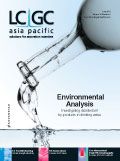Determination of Free and Total Glycerol in Biodiesel
Dionex Application Note
Biodiesel fuels are part of a rapidly growing alternative fuel industry to replace gasoline with renewable, more efficient and lower emission fuels.1 Biodiesel contains diesel fuel blended with 2–20% (B2–B20) of fatty acid methyl esters (FAME), which are manufactured by transesterification of vegetable or animal oils to generate three molecules of free FAMEs and one molecule of glycerol byproduct. Free and bound glycerol from unconverted triglycerides can cause diesel engine failures. Therefore, ASTM D6751 specifies limits for free glycerol and bound glycerol at 0.02 and 0.24 wt % respectively in biodiesel determined using GC–FID.1 However, this method requires sample derivatization, which increases sample handling time and expense. This application brief describes a high-performance anion-exchange chromatography with pulsed amperometric detection (HPAE-PAD) method for free and total glycerol in biodiesel that meets the ASTM limit requirements and eliminates the sample derivatization step.
Experimental
A Dionex ICS-3000 chromatography system with an electrochemical detector was used. For free glycerol determinations, the biodiesel samples were extracted with water and the aqueous layer was removed for analysis. For total glycerol determinations, biodiesel samples were hydrolysed in 1 M NaOH by refluxing at 95 °C for 1 h, cooled and the aqueous layer removed for analysis.1
Results
The method was evaluated by determining the LOD, LOQ and the linearity of response from seven standards (n = 2, 0.05–10 mg/kg glycerol). The method was sensitive, with an LOD (3× S/N) and LOQ (10× S/N) of 0.5 and 2.4 µg/kg, respectively. The linearity in the specified range produced a coefficient of determination (r2 ) of 0.9998.
To evaluate the method for determining free and total glycerol, we analysed ten biodiesel samples. The glycerol peak was well resolved from an unknown peak, as shown in the total glycerol determination of a B100 animal-source biodiesel sample (Figure 1). Free glycerol concentrations ranged from 0.02–11.8 mg/kg (n = 2) while total glycerol concentrations ranged from 0.066–188 mg/kg (n = 2). All glycerol concentrations in the biodiesel samples were within the ASTM specifications of <0.02 (200 mg/kg) and 0.24 wt% (2400 mg/kg), respectively. Recoveries of glycerol added at twice the sample concentrations ranged from 92–100%.

Figure 1: Comparison of total glycerol in an aqueous solution of a base-hydrolyzed B100 animal sample a) without, and b) with 80 mg/kg added glycerol. Sample preparation: base-hydrolysis at 95 °C for 1 h, dilute aqueous layer 1:5, filter 0.2 µm. Column: CarboPac MA1 guard and analytical; eluent: 100 mM sodium hydroxide; temperature: 30 °C; flow-rate: 0.40 mL/min; injection volume: 5 µL; detection: PAD, Au, Waveform A.1 Peaks: 1) Unknown; 2) glycerol [(a) 0.54 mg/kg, (b) 1.3 mg/kg].
HPAE-PAD is a sensitive and selective method that does not require the sample derivatization needed for the GC–FID method, and therefore provides a good alternative for determining µg/kg to mg/kg concentrations of glycerol from aqueous extractions of biodiesel samples.
References
1. Dionex Corporation, Determination of Free and Total Glycerol in Biodiesel Samples by High Performance Anion-Exchange Chromatography with Pulsed Amperometric Detection (HPAE-PAD), Application Note 255, LPN 2571, Sunnyvale, California, USA (2010).
CarboPac and Chromeleon are registered trademarks of Dionex.
Dionex Corporation
1228 Titan Way, P.O. Box 3603, Sunnyvale, California 94088, USA
tel. (408) 737-0700 fax (408) 730-9403
Website: www.dionex.com

Biopharmaceutical Characterization in the Age of Artificial Intelligence
May 13th 2025AI-powered tools are enhancing precision, efficiency, and decision-making in biopharmaceutical development. Recently, Jared Auclair and Anurag Rathore explored AI's evolving role in biopharmaceuticals in detail.
Determining Ways to Protect Honeybee Colonies with GC–MS
May 13th 2025A study conducted by the Agriculture Research Centre of Giza, Egypt, and Jilin Agricultural University in China, evaluated the efficacy of stinging nettle extract, nettle smoke, and formic acid in the controlling of Varroa mites, a major threat to honeybee colonies, with a focus on mite infestation reduction, honeybee mortality, and biochemical responses. Gas chromatography–mass spectrometry (GC–MS) was used to identify key bioactive compounds in the stinging nettle extract.
Evaluating the Accuracy of Mass Spectrometry Spectral Databases
May 12th 2025Mass spectrometry (MS) can be effective in identifying unknown compounds, though this can be complicated if spectra is outside of known databases. Researchers aimed to test MS databases using electron–ionization (EI)–MS.

.png&w=3840&q=75)

.png&w=3840&q=75)



.png&w=3840&q=75)



.png&w=3840&q=75)














